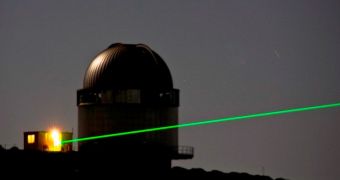The European Space Agency (ESA) recently studied the performances of a new type of laser technology in the Spanish Canary Islands. The study involved firing pulses of green light between two of the islands in the archipelago, and was ultimately determined to be a huge success.
The laser technology is being developed to study climate change and global warming, by keeping track of traces of greenhouse gases in the Earth's atmosphere. As it travels through the air, the light beam picks up information about the chemicals it encounters, and relays them to a receiver.
This system is made up of an emitter and a receiver. For the system installed in the Canary Islands, between Isla de La Palma and Tenerife, the two are spaced about 144 kilometers (89.5 miles) apart.
The former sends out a beam of laser light at a particular wavelength, heading towards the Tenerife-based receivers. As it moves through the air, it can analyze carbon dioxide and methane concentrations in the air. Unlike other types of light studies, it uses infrared rather than microwave wavelengths.
By using this technology aboard satellites, it may be possible to analyze Earth's atmosphere through an innovative new method that would augment and verify data collected from other sources. However, in order to ensure that is possible, scientists needed to be sure that the approach is feasible.
Theories underlying the system have been proposed years ago, but it was only this year that sufficient funding was acquired to actually install the laser generator and receiver in the Spanish archipelago.
“The campaign has been a crucial next step towards realising infrared-laser occultation observations from space. We are excited that this pioneering inter-island demonstration for measuring carbon dioxide and methane was successful,” says Gottfried Kirchengast.
The expert is part of a team of scientists from the University of Graz Wegener Center, in Austria, which conducted the work with colleagues in the United Kingdom, at the University of York and the University of Manchester.
“It was a challenging experiment to coordinate, but a real pleasure to work with the motivated teams of renowned scientists and young academics,” explains Armin Löscher, an official with the Future Mission Division at ESA.
While the study was ongoing, people on the two islands could not see the infrared light, but they could see the green guidance laser lighting up the night sky at regular interval. The science team is currently investigating the acquired data, cross-referencing them to established databases.

 14 DAY TRIAL //
14 DAY TRIAL //